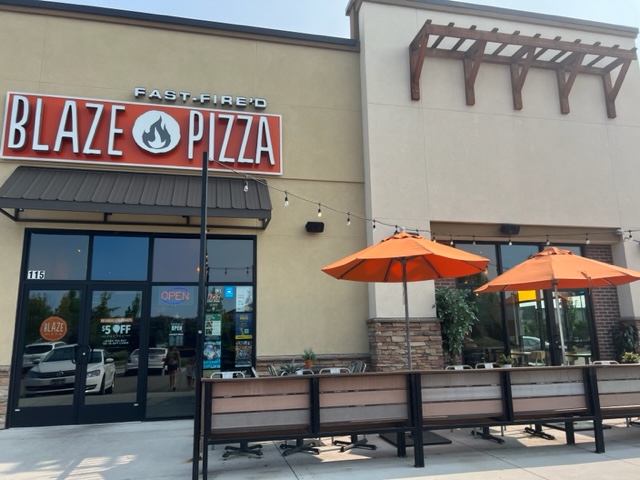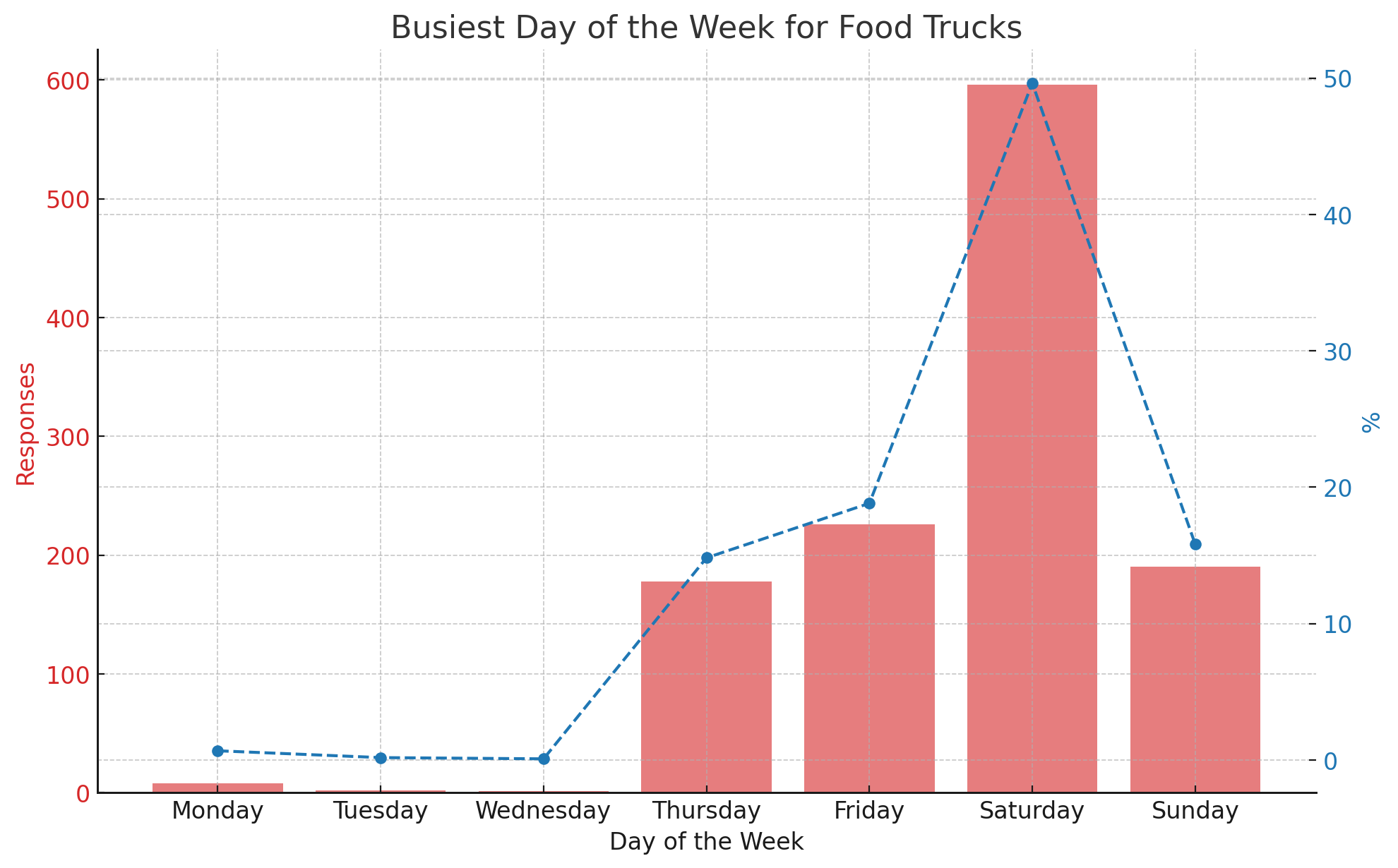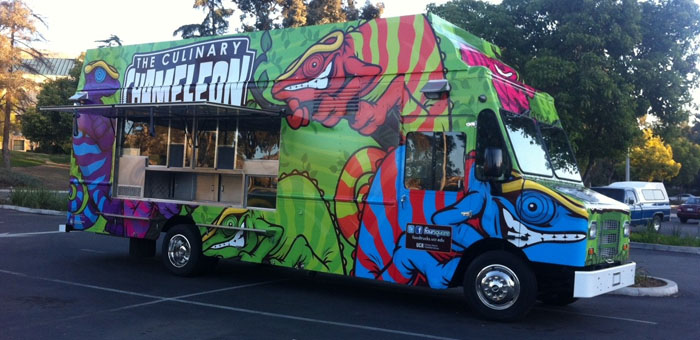We’ve seen this movie before. Innovative mom-and-pop enterprises establish a new industry niche, only to be boxed out by larger players wielding deeper pockets, driving ambition and economies of scale. In this case, restaurant chains and franchises are muscling their way into a unique form of dining, the food truck. Time will tell whether there is enough room for both the chains and the independents to survive this man-eats-hotdog death match.
Page Contents
The Food Truck Industry Continues To Grow
The beginning of the 21st century was the golden era for independent food trucks featuring hip, innovative food and consumer-friendly prices. These trucks proved that fast food need not be junk, and many a lunch break was spent outdoors by hungry workers digging into glorious food-truck dishes from around the world as well as local comfort food. Evidence clearly shows that the food truck phenomenon is no fad, but rather a permanent and popular feature within the culinary scene.
The food-truck niche has grown from sales of $650 million in 2013 to a projected $2.7 billion in 2017. The number of food trucks operating in the U.S. is estimated at 30,000 to 40,000, and most of the trucks are custom-built. With investments beginning below $100,000, popular food trucks can pull in between $250,000 and $500,000 a year, which is enough to kindle the entrepreneurial spirit in many a chef, whether budding or experienced.
It wasn’t long before cities sniffed out a good thing and began issuing various regulations, licenses and fees in order to grab their piece of the pie. This, coupled with increasing competition and a drive toward more sophisticated fare, has driven up the price for starting and running a food truck operation, although brick-and-mortar restaurants face much higher barriers to entry.
Restaurant Chains Are Quickly Entering The Food Truck Industry
Franchises and restaurant chains saw the potential to expand their businesses without laying out the hundreds of thousands of dollars needed to build another establishment. Furthermore, mobile trucks solve one of the biggest risks that new restaurants face – picking a location that will support a profitable business. Food trucks go where the people are, while old-fashioned restaurants must wait to be discovered by local customers.
You are seeing many of the nation’s most familiar names jumping into the food-truck niche, including Dunkin Donuts, Starbucks, White Castle, Texas Roadhouse, Nathan’s, Aunt Annie’s, Philly Cheesesteak, TGIF Fridays, McDonald’s, Taco Bell, In-N-Out Burger, Sizzler, Applebee’s, Fuddtruckers, Pizza Hut, Steak n Shake, Hard Rock Café, California Pizza Kitchen and many more. Some current estimates put the brick-and-mortar ownership share of food trucks at 30 to 40 percent, up from only 10 percent in 2015. While most food trucks emphasize affordable, casual dining, some trucks, especially ones deployed by fancy restaurants, are looking to go up-scale. The jury is out on whether street traffic will be willing to shell out $14 for a paté-and-cheese plate.
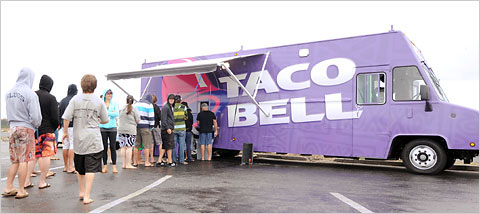
Taco Bell food truck.
The most compelling stories arise from local restaurants that expand their operations into the food-truck niche. The benefits are clear-cut.
Primary Benefits To Restaurant Chains Using Food Trucks
- Catering and Event Opportunities: Food trucks can tap into the catering market, serving at private events, weddings, festivals, and corporate functions. This opens up additional revenue streams beyond daily street sales. In-N-Out Burger at your wedding? It’s possible thanks to mobile food units.
- Advertising: What better way to drill a restaurant’s name into the popular consciousness than a food truck prominently displaying the address of the affiliated restaurant(s)? The mobile eatery can hit all the city’s hot spots, enticing customers to come visit the truck’s brick-and-mortar big brother. The monthly savings on advertising costs can be enormous, easily hitting several hundreds of thousands of dollars. Each new neighborhood the truck visits has the potential to create new, loyal customers for the main restaurant.
Another aspect of free advertising is the whole cable-TV food-truck craze. Several food shows, such as Eat St., regularly feature mobile trucks, which can cause demand for the truck and its parent restaurant to explode.
- Site testing: It takes a lot of money to open a franchise at a new location. Before risking all that money, a savvy businessperson can gauge local demand by parking a food truck at the contemplated locale and seeing how many people show up. Owners can track traffic and demographics before committing to a brick-and-mortar establishment. Furthermore, the mobility of a food truck helps the erstwhile franchisee determine which of several possible sites will have the best chances of succeeding.
- Menu testing: A mother-ship restaurant might be a little shy about alienating loyal customers by introducing new menu items that are unique or experimental. However, food trucks live for outlandish, bizarre and breakthrough dishes with the potential to create a buzz that attracts customers. One a recipe proves its worth on the streets, the main restaurant will face less risk replacing a traditional dish with the new one.
- Goodwill: A savvy restauranteur knows the value of doing (well-publicized) good deeds, like feeding folks at a charity event or in the wake of a natural or man-made disaster. Charities that hire hip food trucks will likely attract more visitors to an event and drum up more contributions.
Does this create a branding risk for the food truck industry?
Food trucks are usually thought of as scrappy startups, run by passionate chefs. But if too many brands get into the food truck game, will it hurt the food truck industry image of being able to get gourmet and unique food?
The entry of big brands into the food truck industry can indeed influence perceptions and dynamics within the market, potentially affecting the “cool” factor associated with food trucks. Here are some risks of too many big brands getting in on this trend.
- Dilution of Authenticity: Food trucks have traditionally been seen as grassroots, entrepreneurial ventures offering unique, local, or niche culinary experiences. The influx of big brands could dilute this perception, making food trucks feel more commercialized and less authentic to some consumers.
- Market Saturation: As more restaurant chains launch food trucks, there’s a risk of market saturation. An oversaturated market could make it harder for individual trucks to stand out, potentially leading to consumer fatigue and a decrease in the novelty that made food trucks appealing.
- Competition for Independent Operators: Small, independent food truck operators might find it challenging to compete with big brands that have more resources for marketing, operations, and prime location access. This competition could squeeze out smaller players, reducing the diversity that makes food truck scenes vibrant and appealing.
- Homogenization of Offerings: Big brands might stick to tested formulas and popular menu items, leading to a homogenization of food truck offerings. This could reduce the variety and innovation that food truck aficionados appreciate, making the scene less interesting.
- Consumer Perception Shift: Some consumers specifically seek out food trucks for unique dining experiences outside the mainstream restaurant industry. The presence of big brands could shift this perception, making food trucks feel like an extension of the conventional dining scene rather than an alternative to it.
The Bottom Line
Reactionary brick-and-mortar restaurants that sniff at the very idea of food trucks sometimes push for ordinances or leases that ban the trucks from parking too close. But the food-truck revolution is also drawing more restaurants into the mobile niche.
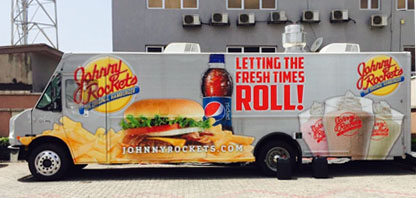
Johnny Rockets food truck.
For example, the well-known diner Johnny Rockets opened several food trucks around the globe in 2016, at exotic locations like La Serena, Chile and Lagos, Nigeria. But Johnny Rockets is not new to the food-truck game, having opened a Washington D.C. truck about eight years ago as a cross-promotion with the Redskins NFL team. At that time, demand was so large that it overwhelmed the truck’s capacity. Johnny Rockets returned to the niche three years later, better prepared due to aggressive product capacity.
In the end, it’s the hungry, time-challenged masses who will decide which trucks make it and which ones fail.

